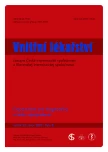Paradoxical Embolization and Patent Foramen Ovale in scuba divers: screening possibilities
Authors:
T. Honěk 1; J. Veselka 1; A. Tomek 2; M. Šrámek 2; J. Januška 3; L. Šefc 4; R. Kerekeš 5; Š. Novotný 6
Authors‘ workplace:
Kardiovaskulární centrum FN Motol, Praha, přednosta doc. MUDr. Josef Veselka, CSc., FESC, FSCAI
1; Neurologická klinika 2. lékařské fakulty UK a FN Motol, Praha, přednosta doc. MUDr. Martin Bojar, CSc.
2; Kardiocentrum Nemocnice Podlesí a. s. Třinec, přednosta prim. MUDr. Marian Branny
3; Ústav patologické fyziologie 1. lékařské fakulty UK, Praha, přednosta prof. MUDr. Emanuel Nečas, DrSc.
4; Interní oddělení SZZ Krnov
5; Hyperbarická komora a poradna pro potápěče, Kladno, vedoucí MUDr. Štěpán Novotný
6
Published in:
Vnitř Lék 2007; 53(2): 143-146
Category:
Original Contributions
Overview
Introduction:
The cause of decompression sickness (DCS) in scuba-divers is bubble formation in tissues and venous blood during ascent. Divers with patent foramen ovale (PFO) have an increased risk of paradoxical embolization to the brain or other vital organs. The aim of our study was to asses the incidence of PFO in scuba-divers with DCS; compare the group with asymptomatic controls and to evaluate ultrasound contrast method suitable for screening. Methods: We examined 28 scuba-divers (more than 100 dives). The right to left shunt detection was performed by bubble contrast transthoracic echocardiographic examination (TTE) and transcranial Doppler sonography over arteria cerebri media (TCD) in all divers. In divers with shunting transoesophageal echocardiography (TEE) was performed to prove PFO. Results: 15 divers had DCS associated with the ascent. In this group, PFO was diagnosed in 53 % (8/15). The symptoms of all of them retrospectively were of paradoxical embolization (neurological form of DCS). In a group of asymptomatic divers PFO was proved on the basis of right-to-left shunt screening in 1 diver (8 % 1/13). TCD proved right-to-left shunt in all divers with PFO. Conclusions: DCS can unmask a so far asymptomatic intracardiac right to left shunting. PFO is a risk factor for paradoxical embolization in divers. TCD is suitable for screening; TEE is a gold standard in PFO detection. Our results showed that PFO detection is a useful clinical tool after repeated DCS and in all frequent divers and instructors.
Key words:
patent foramen ovale - scuba diving - decompression sickness
Sources
1. Weathersby PK, Homer LD, Flyn ET. Homogenous nucleation of gas bubbles in vivo. J Appl Physiol 1982; 53 : 940-946.
2. Dutka AJ, Francis TJ. Patophysiology of decompression sickness. In: Bove AA (ed). Bove and Davis’ diving medicine. Philadelphia: WB Saunders 1997.
3. Sykes JJ, Yaffe LJ. Light and electron microscopic alteration in spinal cord sheats after decompression sickness. Undersea Biomed Res 1985; 12 : 251-258.
4. Waren RA, Philips RB, Inwood MJ. The ultrastructural morphology of air embolism: Platelet adhesion to the interface end endothelial damage. Br J Exp Pathol 1973; 54 : 163-172.
5. Ward CA, Mc Cullough D, Fraser WD. Relation between complement activation and succeptibility to decompression sickness. J Appl Physiol 1987; 62 : 1160-1166.
6. Hitler BD, Hilus BA. The lung as a filter for microbubbles. J Appl Pfysiol 1979; 47 : 537-543.
7. Niden AH, Aviado DM. Effects of pulmonary embolism on the pulmonary circulation with special reference to arterio-venous shunts in the lung. Circ Res 1956; 4 : 67-73.
8. Vik A, Jenssen BM , Brubakk AO. Arterial gas bubbles after decompression in pigs with patent foramen ovale. Undersea Hyperb Med 1993; 20 : 121-131.
9. Vik A, Jenssen BM, Brubakk AO. Paradoxical air embolism in pigs with a patent foramen ovale. Undersea Biomed Res 1992; 19 : 361-374.
10. Gerriets T, Tetzlaff K, Liceni T et al. Arteriovenous bubbles following cold water sport dives: Relation to right-to-left shunting. Neurology 1999; 55 : 1741-1743.
11. Wilmhurst PT, Byrne PC, Webb-Pebloe MM. Relation between interatrial shunts and decompression sickeness in divers. Lancet 1989; 2 : 13002-13006.
12. Moon RE, Camporesi EM, Kisslo JA. Patent foramen ovale and decompression sickness in divers. Lancet 1989; 1 : 513-514.
13. Kerut EK, Trias WD, Borreson TE et al. Detection of right to left shunts in decompression sickness in divers. Am J Cardiol 1997; 79 : 377-388.
14. Bove AA. Risk of decompression sickness with patent foramen ovale. Undersee Hyperb Med 1998; 25 : 175-178.
15. Torti SR, Billinger M, Schwerzmann M et al. Risk of decompression illness among 230 divers in relation to the presence and size of patent foramen ovale. EHJ 2004; 25 : 1014-1020.
16. Honěk T, Tomek A, Šrámek M et al. Dekompresní příhoda u potapěčů a vyšetření PFO. Cor Vasa 2006; 48 : 286-288.
17. Carturan D, Boussuges A, Vanuxem P et al. Ascent rate, age, maximal oxygen uptake, adiposity and circulating bubbles after diving. J Appl Physiol 2002; 93 : 1349-1356.
18. Germonpre P, Hastir F, Dendale P et al. Evidence for increasing patency of the foramen ovale in divers. Am J Cardiol 2005; 95 : 912-915.
19. Walsh KP, Wilmshurst PT, Morrison WL. Transcatether closure of paternt foramen ovale using the Amplatzer septal ocluder to prevent recurrence of neurological decompression illness in divers. Heart 1999; 81 : 257-261.
20. Lier H, Hering R, Schroeder S. Diving and patent foramen ovale: time for a change in fitness to dive certifications? Clin J Sport Med 2005; 15 : 205-207.
Labels
Diabetology Endocrinology Internal medicineArticle was published in
Internal Medicine

2007 Issue 2
Most read in this issue
- Fever of unknown origin – etiology and diagnostic algorithm
- Czech Atherosclerosis Society Guidelines for the Diagnosis and Treatment of Dyslipidemias in Adults
- Encapsulating peritoneal sclerosis
- Long term effectiveness of surgical cryoMAZE ablation for chronic atrial fibrillation in patients undergoing surgery for severe mitral valve regurgitation
